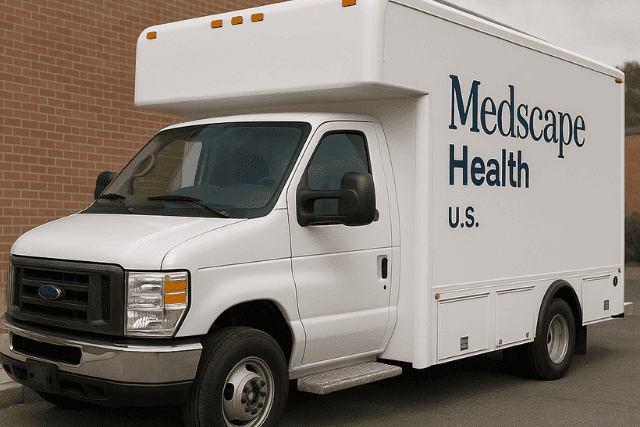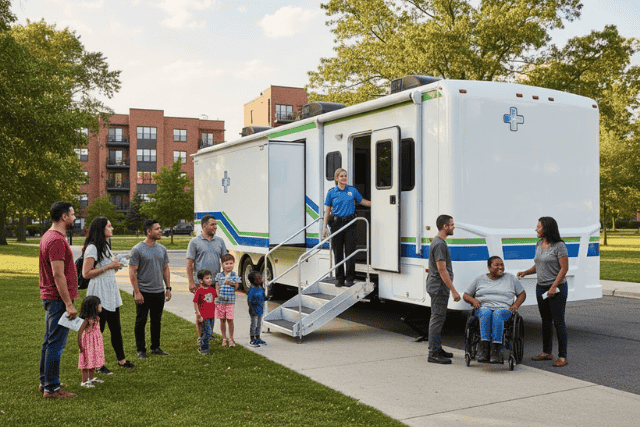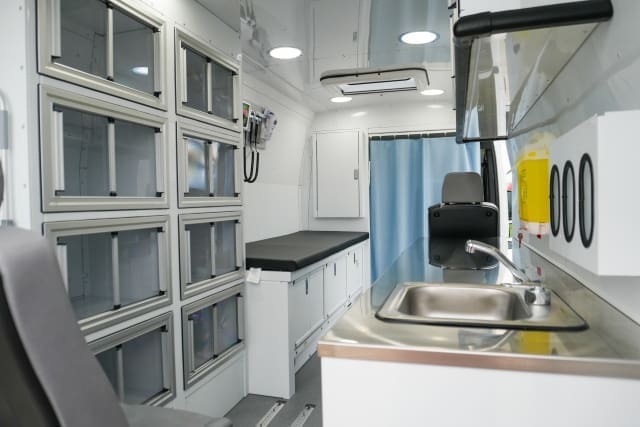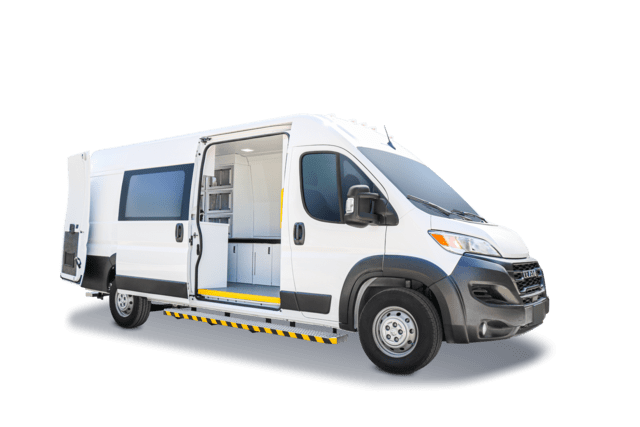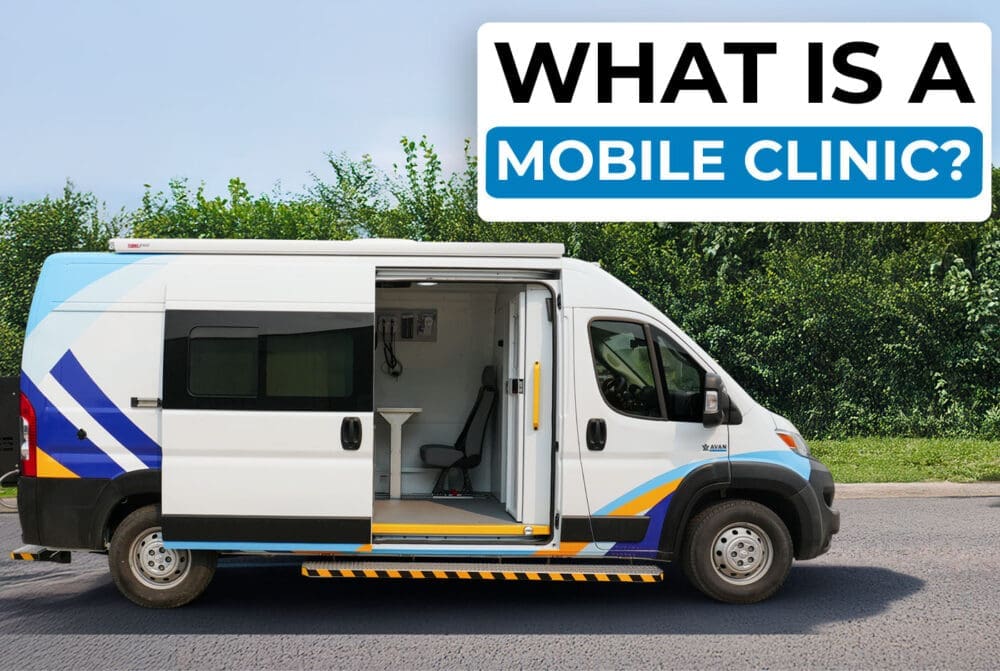Over 15% of U.S. adults live in rural areas with limited access to healthcare. That’s millions of people who struggle to get the care they need simply because of where they live.
That’s probably why you’re exploring mobile medical units. But now you’re stuck on the question: What is a cutaway chassis? And more importantly, is it right for your organization?
You might be feeling uncertain. Maybe even a little overwhelmed. You’re responsible for delivering care, not designing vehicles. But here’s the thing. Picking the wrong base vehicle could mean frequent breakdowns, cramped interiors, or a layout that doesn’t work for your team. That gap between what you need and what you get can cost time, money, and trust from the people you’re trying to serve.
Now picture this: Your mobile unit shows up on time, fully equipped, and ready to care for anyone who walks through the door. That’s what the right foundation helps you achieve.
At AVAN Mobility, we’ve been building mobile medical vehicles for over 10 years. We’re Ford QVM and Stellantis QPro certified. We’ve partnered with healthcare providers like you and Pacific Clinics across the U.S., manufacturing mobile clinics, outreach units, and mental health units. While we do build these vehicles ourselves, our goal here is to educate you, not pitch you.
Here’s what you’ll learn:
- What a cutaway chassis is
- Why it’s used in mobile units
- The biggest drawback that come with it
- What other chassis types you can consider
Ready? Let’s dig in.
What is a cutaway chassis?
From a manufacturing standpoint, a cutaway chassis is a type of vehicle where the front cab is fully built, but the back is open and unfinished. The open rear section is where another company, often a vehicle upfitter, adds a custom-built body based on how the vehicle will be used.
In simple terms: The front is ready to drive, and the back is ready to build on.
You’ll often see a cutaway van chassis used in industries that need customized interiors, including:
- Mobile clinics: Outfitted with exam spaces, refrigeration, or basic lab setups
- Ambulances: Built to handle stretchers and medical gear
- Delivery trucks and shuttles: Designed for cargo or passenger transport
Examples on the market: Vehicles like the Ram ProMaster cutaway chassis or Ford E-Series are frequently chosen for these kinds of builds. These chassis types are rear-wheel drive and often have stronger frames to handle more weight.
Picture it like this: From the front, it looks like a regular commercial van. But walk around to the back, and it’s an open frame waiting to become something else. That’s the role of a cutaway van chassis in mobile unit design.
Coming up next, we’ll break down why a cutaway chassis is used in some mobile medical units, and later, some of the biggest challenges that can come with using this setup.
Why is a cutaway chassis used in mobile medical units?
You might wonder why some mobile medical units are built on a cutaway chassis. The short answer: It gives manufacturers some additional room to work with and a blank space in the back to create the setup you want.
Here are a few reasons why people choose it:
- More space inside: There’s usually extra headroom and floor space to fit bigger equipment or create private rooms.
- Custom layout: The open back lets manufacturers design the inside how you want it. Some organizations want a waiting area, exam room, or wheelchair lift.
- Built for weight: A cutaway van chassis, like the Ram ProMaster cutaway chassis, is strong. It can carry things like generators, water tanks, and medical tools.
- Easy to move around: Some cutaway chassis designs let you walk from the driver’s seat into the clinic area without going outside. That’s helpful in bad weather.
You’ll often see a cutaway van chassis for sale used for things like:
- Dental vans
- Blood donation units
- Imaging and screening clinics
It’s a popular choice when size and power are important. But not every organization needs something that big, or wants to deal with how it handles on the road.
Next, let’s talk about the biggest drawbacks of using a cutaway chassis for mobile medical work.
What are the biggest drawbacks of using a cutaway chassis for mobile medical work?
A cutaway chassis might give you some extra room and flexibility, but it also comes with trade-offs that are important to think through before you commit. Here are the most common issues organizations run into when using a cutaway van chassis for mobile healthcare.
Higher upfront and build-out costs
More work, more money: Since the rear body is custom-built, these units usually come with a higher price tag than something pre-assembled. The chassis is only the beginning. You still have to pay for the body, the interior layout, insulation, wiring, and medical-grade finishes. If you’re looking at a cutaway van chassis for sale, the sticker price doesn’t tell the whole story.
Learn about the cost of a mobile medical van from AVAN Mobility.
More complex to repair
Two systems, two headaches: If something breaks, who do you call: The chassis dealer or the upfitter? Repairs can be more complicated and slower because multiple companies may be involved. Finding replacement parts might also take longer if the build is fully custom.
Bigger and harder to handle
Not great for city driving: A cutaway van chassis is larger and bulkier than other options, like a cargo van. Tight turns, narrow roads, and parking lots become harder to navigate. This matters a lot if your unit will be used in busy cities or small communities.
Lower fuel efficiency
More weight, more gas: These vehicles tend to burn more fuel, especially when carrying heavy equipment or multiple staff members. If your team travels long distances, those gas bills can get high fast.
Slower build timelines
Custom builds take time: Since nothing is off-the-shelf, cutaway units can take longer to design and finish. If you’re on a deadline to launch your mobile clinic, this could delay your timeline by several months.
More permits and compliance steps
Heavier weight, more red tape: In some states, the larger size and higher weight of a cutaway van chassis may push you into commercial vehicle regulations. That could mean extra inspections, licensing, or insurance requirements, depending on how your organization operates.
What other chassis types can you consider?
If a cutaway chassis sounds like more than you need or just doesn’t fit how your team works, there are other vehicle types worth considering. These options are often easier to drive, quicker to build, and better for smaller teams or lighter equipment.
Here are a few popular choices:
Ram ProMaster 159″ high-roof
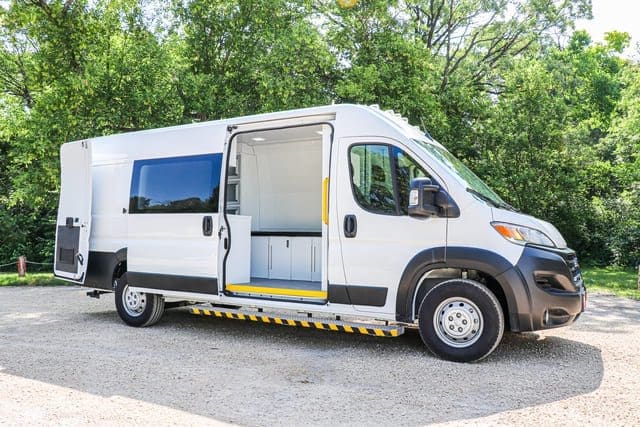
Great for mobile clinics with limited space needs: This model gives you a tall interior you can stand up in and plenty of room to add equipment. It’s easier to drive than a cutaway van and fits in tighter spaces. It’s front-wheel drive, which helps in rain and snow, especially in rural areas or colder states.
In addition, it’s also:
- Easier to drive and park
- Lower fuel costs
- Shorter build timelines
- Great for primary care, mental health, or outreach programs
Ford Transit high-roof extended

Flexible and widely available: The Transit is another top choice for mobile medical use. Like the ProMaster, it offers a high-roof design so most people can stand up inside.
Mercedes-Benz Sprinter
Premium option with strong resale value: The Sprinter offers diesel models and advanced safety features. It’s known for a smooth ride and clean interior finish. It can cost more, but it may last longer with regular maintenance.
Each of these options has trade-offs, just like the cutaway van chassis. What matters most is how your team works, where you plan to drive, and what kind of care you’ll provide.
How do you choose the right chassis for your mobile medical program?
Choosing the right chassis is one of the biggest decisions you’ll make when starting a mobile clinic. It’s about picking the base that supports your team, your services, and your community.
Here’s a simple list to help you figure out what might work best for you:
1. Where will you drive?
City streets or rural roads? If you’re mostly in urban areas, a smaller van like the Ram ProMaster 159″ high-roof is easier to drive and park. A larger cutaway chassis might handle the load better if you’re covering long distances on highways only.
2. How much space do you need?
Think about your setup: Do you need one exam room or two? A waiting area? A lift? More rooms often mean a bigger vehicle, but don’t forget about layout options in smaller vans, too.
3. What’s your budget?
Be realistic about total costs: A cutaway van chassis might seem like the obvious choice for space, but build-out costs, gas, and maintenance can add up fast. A smaller chassis may stretch your budget further.
4. What kind of care are you offering?
Different services need different setups: A dental unit needs more power and equipment space than a counseling van. Make a list of must-haves, then match that to the chassis.
Still deciding? That’s totally normal. In the next section, we’ll give you some next steps to help you move forward with clarity, not pressure.
Got any questions about the cutaway chassis?
You came here looking for answers about a cutaway chassis and how it could fit into your mobile medical plans. Maybe you were feeling unsure about the best direction to take or worried about making a costly mistake that would slow your program down.
Here’s a quick recap of what you’ve learned:
- What a cutaway chassis is and how it works in medical vehicle builds
- Where it helps and where it can fall short
- Other chassis options like the Ram ProMaster 159″ high-roof, that might suit your goals better
- What questions to ask when choosing the right chassis for your team
At AVAN Mobility, we’ve helped dozens of healthcare teams across the U.S. launch mobile clinics that serve real people, in real places, with real impact. Our team has spent years learning what works on the road and how the right vehicle design can make or break your program.
We bring engineering know-how, hands-on experience, and care for the people who rely on you. We’re proud to be a trusted partner to organizations that are doing life-changing work across the country. If you have questions, click the button below to talk to a mobility expert who’s ready to help.
If you’re not ready to connect with a mobility expert yet, we’ve got a few other resources that can help you keep learning.
You’ll want to check out our article on securing grants for mobile health clinics, especially if funding has been one of your top concerns.
After that, read our article on the top five problems you’ll face with a longer wheelbase on mobile medical vehicles. This is important since you’re likely in the stage where you’re considering various chassis setups.
